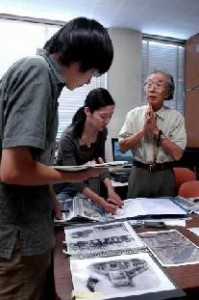Conveying the A-bomb Experience, Part 2
Jul. 5, 2010
Computer animation to bring lost neighborhood back to life
by Kunihiko Sakurai, Masaki Kadowaki, and Takahiro Yamase, Staff Writers
The heat of the atomic fire, the agony of burned bodies, the grief wrought by families torn apart, the rage felt toward war… What should be done to etch the experiences borne of that day in our minds and in our memories, for generations to come, as the A-bomb survivors (hibakusha) and the family members of the A-bomb victims age? In this series (originally published in July and August 2004), the Chugoku Shimbun will consider the significance and challenges of conveying the A-bomb experience, with a focus on new efforts taking place in the A-bombed city of Hiroshima.
A cherry tree stood in front of the main hall of the temple. He often played tag in the cemetery there. The temple lay at one corner of a downtown district that included shops and a post office. People of the area regularly strolled the grounds of the temple, known as "Ofudo-san," which meant "God of Fire." Nenkai Aoyama, 75, a resident of Higashi-Hiroshima City, reflected on those days of 59 years ago and began to share his story.
On July 13, Mr. Aoyama studied a map at Hiroshima University's Research Institute for Radiation Biology and Medicine (RIRBM) in Minami Ward, Hiroshima. It was a map recreated to depict the old district of Saiku-machi (now part of Naka Ward) and Mr. Aoyama was looking for the Sairenji Temple, where he used to live. The temple, which was located beneath the explosion of the atomic bomb, was eventually rebuilt and again stands just east of the A-bomb Dome, formerly called the Hiroshima Prefectural Industrial Promotion Hall.
Over the course of three hours, Mr. Aoyama shared his memories. When staff members of RIRBM expressed their gratitude, he bowed his head and said, "I'm sorry, I can't speak about it well. Until today, I had kept the memories locked away."
On the day of the bombing, Mr. Aoyama left Seirenji Temple a little after 7 o'clock in the morning. When the blast occurred, he was at a Mitsubishi Heavy Industries factory, where he had been mobilized for the war effort. Returning to the temple, he found human remains in the rubble of what he believed to be the kitchen of the priest's living quarters. It was his mother, Hisako, who had been asleep when he left the temple. "All my friends in the neighborhood were killed," he said. "It was too painful to talk about."
A turning point came when he lost his younger brother three years ago due to cancer. Around the same time, he was contacted by Masaaki Tanabe, 66, the president of a film production company in Hiroshima, about a project involving the restoration of the appearance of the old Saiku-machi district, which vanished in the bombing, via computer animation. The project, called "Hiroshima Ground Zero," is restoring the hypocenter-area neighborhood digitally with the support of researchers at RIRBM and other universities. Learning that the project needed the cooperation of former residents of Saiku-machi, Mr. Aoyama volunteered to offer his A-bomb account.
Young people with no experience of war or the atomic bombings listened to Mr. Aoyama's story. Chiharu Yoneda, 24, a resident of Nishi Ward, works for Mr. Tanabe as a project manager. On September 11, 2001, Ms. Yoneda was at a location about five kilometers from "ground zero" of the terrorist attacks in New York City.
The two World Trade Center towers disappeared that day, along with a score of people and the vivacity of the city. With New York in such a state, Ms. Yoneda thought of her hometown, Hiroshima. "What disappeared, what was lost due to the atomic bombing? What were the incredible sacrifices that helped create the current conditions of peace?" After joining Mr. Tanabe's company last spring, she has listened to the stories of more than 50 A-bomb survivors. The bombing occurred, however, 35 years before she was born. As a result, she has felt some frustration at not being able to find answers to the questions she posed to herself in New York. At the same time, she is driven by the desire to convey the atomic bombing to future generations.
Hideyuki Nishizuru, 22, a resident of Naka Ward and a first-year graduate student at the Hiroshima Institute of Technology, will help create the computer animation. "Above all, I want to restore the appearance of the town, faithful to the survivors' memories. I want to restore everything in the area, including the buildings and the people that were blown away by the blast." He has already listened to more than ten former residents. With neighbors caring for each other, people lived together as a community in Saiku-machi, which was fated to lie at the hypocenter of the bombing. Mr. Nishizuru expressed his enthusiasm for the project, saying that he wanted to recreate a sense of the close ties of the former community.
(Originally published on July 22, 2004)








